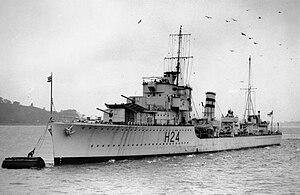HMS Hasty (H24)
 |
|
| History | |
|---|---|
|
|
|
| Name: | HMS Hasty |
| Builder: | William Denny & Brothers, Dumbarton |
| Laid down: | 15 April 1935 |
| Launched: | 5 May 1936 |
| Completed: | 11 November 1936 |
| Fate: | Torpedoed by the German motor torpedo boat S-55 on 14 June 1942, sunk near Crete by Hotspur on 15 June 1942. |
| General characteristics as built | |
| Class and type: | H-class destroyer |
| Displacement: | |
| Length: | 323 ft (98.5 m) |
| Beam: | 33 ft (10.1 m) |
| Draught: | 12 ft 5 in (3.8 m) |
| Installed power: | 34,000 shp (25,000 kW) |
| Propulsion: |
|
| Speed: | 36 knots (67 km/h; 41 mph) |
| Range: | 5,530 nmi (10,240 km; 6,360 mi) at 15 knots (28 km/h; 17 mph) |
| Complement: | 137 (peacetime), 146 (wartime) |
| Sensors and processing systems: |
ASDIC |
| Armament: |
|
| Notes: | Pennant number H24 |
HMS Hasty was an H-class destroyer built for the Royal Navy during the mid-1930s. She was assigned to the Mediterranean Fleet until the beginning of World War II. The ship transferred to Freetown, Sierra Leone, in October 1939 to hunt for German commerce raiders in the South Atlantic with Force K. Hasty returned to the British Isles in early 1940 and covered the evacuation of Allied troops from Namsos in early May 1940 during the Norwegian Campaign. She was transferred back to the Mediterranean Fleet shortly afterwards and participated in the Battle of Calabria and the Battle of Cape Spada in July 1940. The ship took part in the Battle of Cape Matapan in March and evacuated British and Australian troops from both Greece and Crete in April and May. In June, Hasty participated in the Syria-Lebanon Campaign and was escorting convoys and the larger ships of the Mediterranean Fleet for the next year. During the Second Battle of Sirte in March 1942 she defended a convoy from an Italian battleship and several cruisers. While covering another convoy from Alexandria to Malta in June 1942 during Operation Vigorous, Hasty was torpedoed by a German motor torpedo boat and was so badly damaged that she had to be scuttled.
...
Wikipedia
